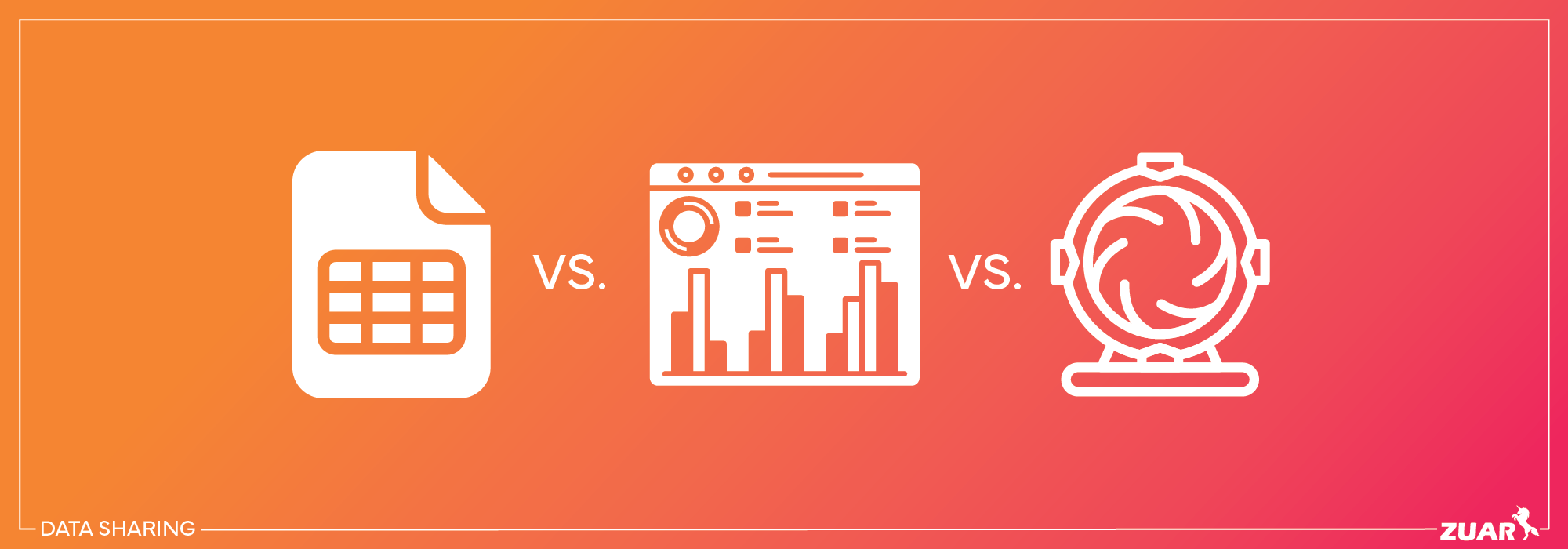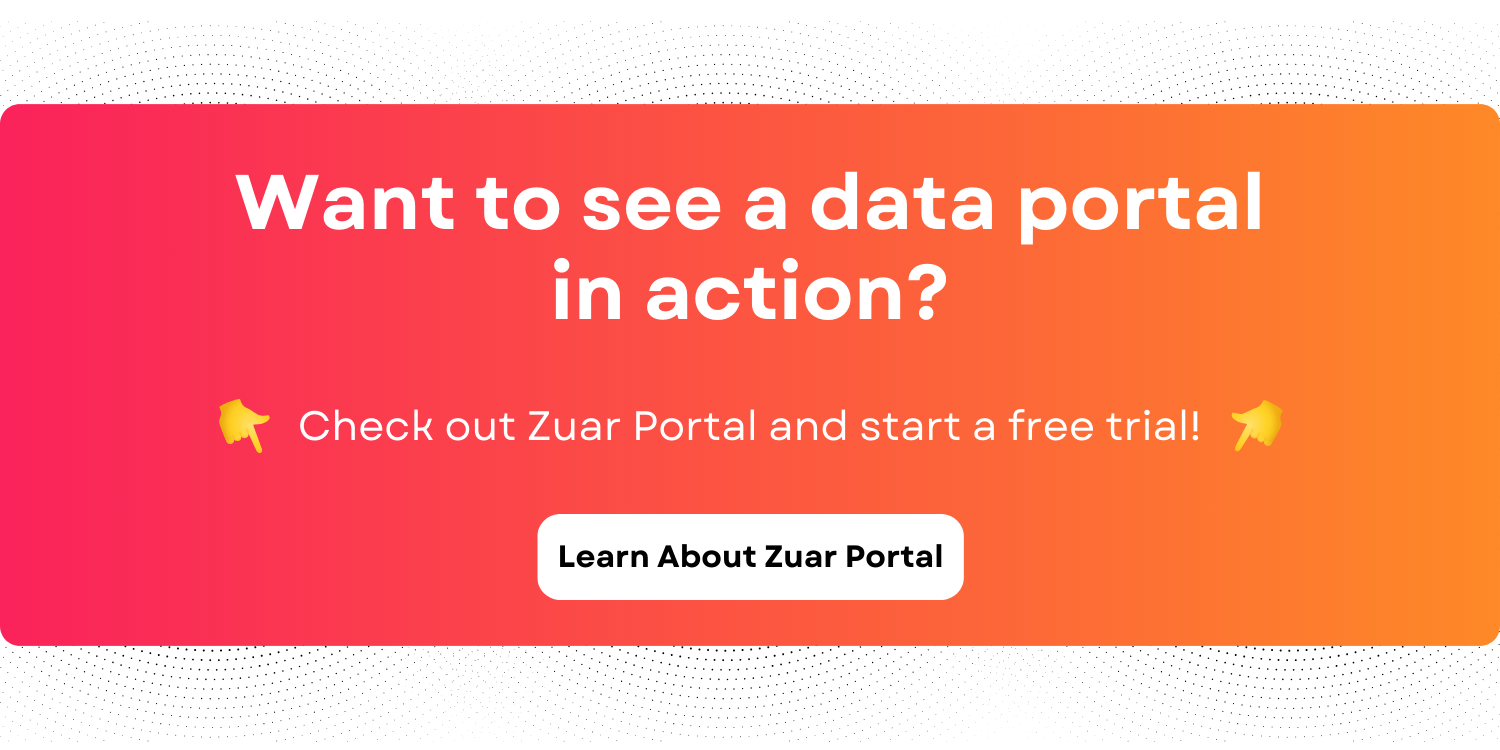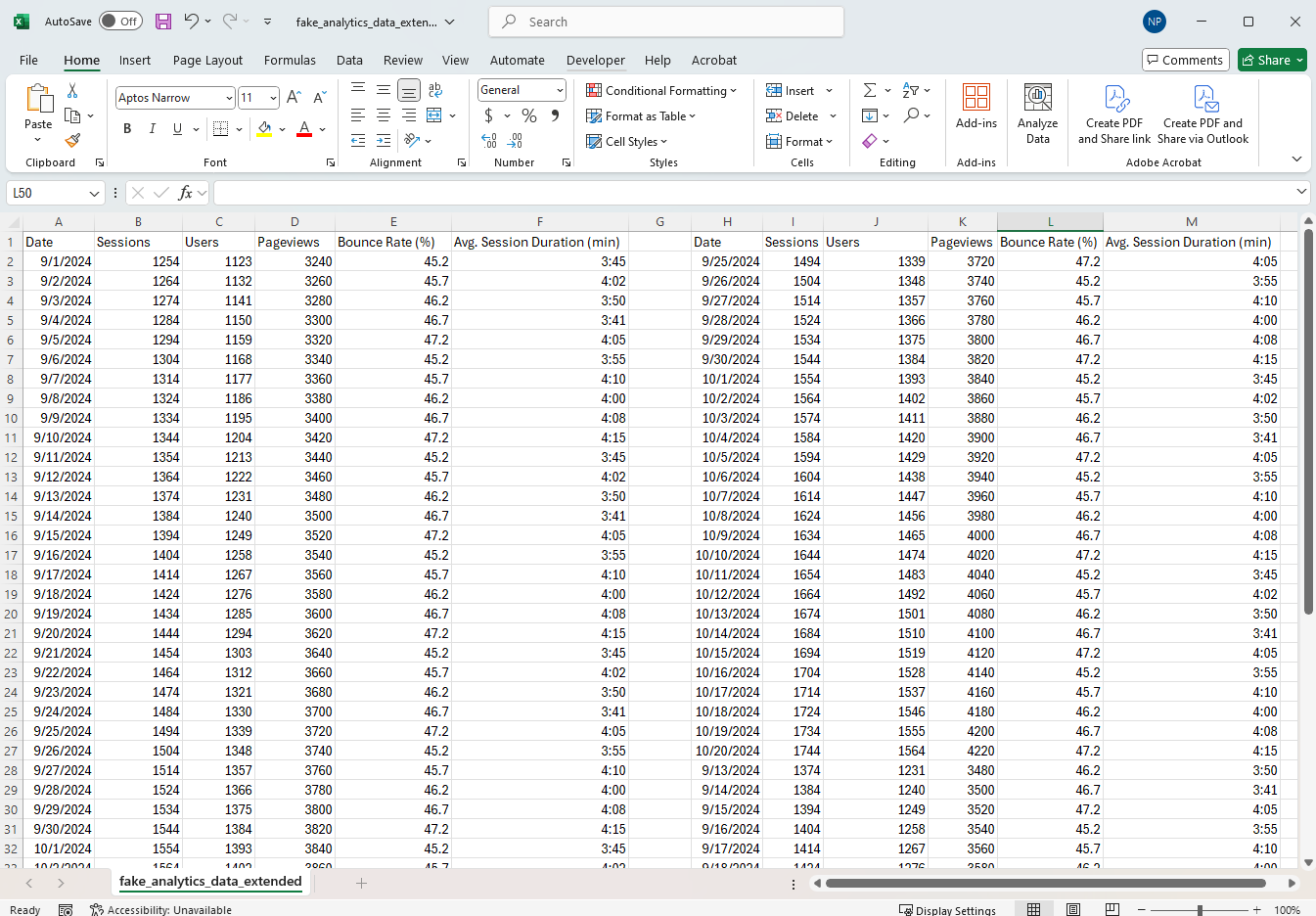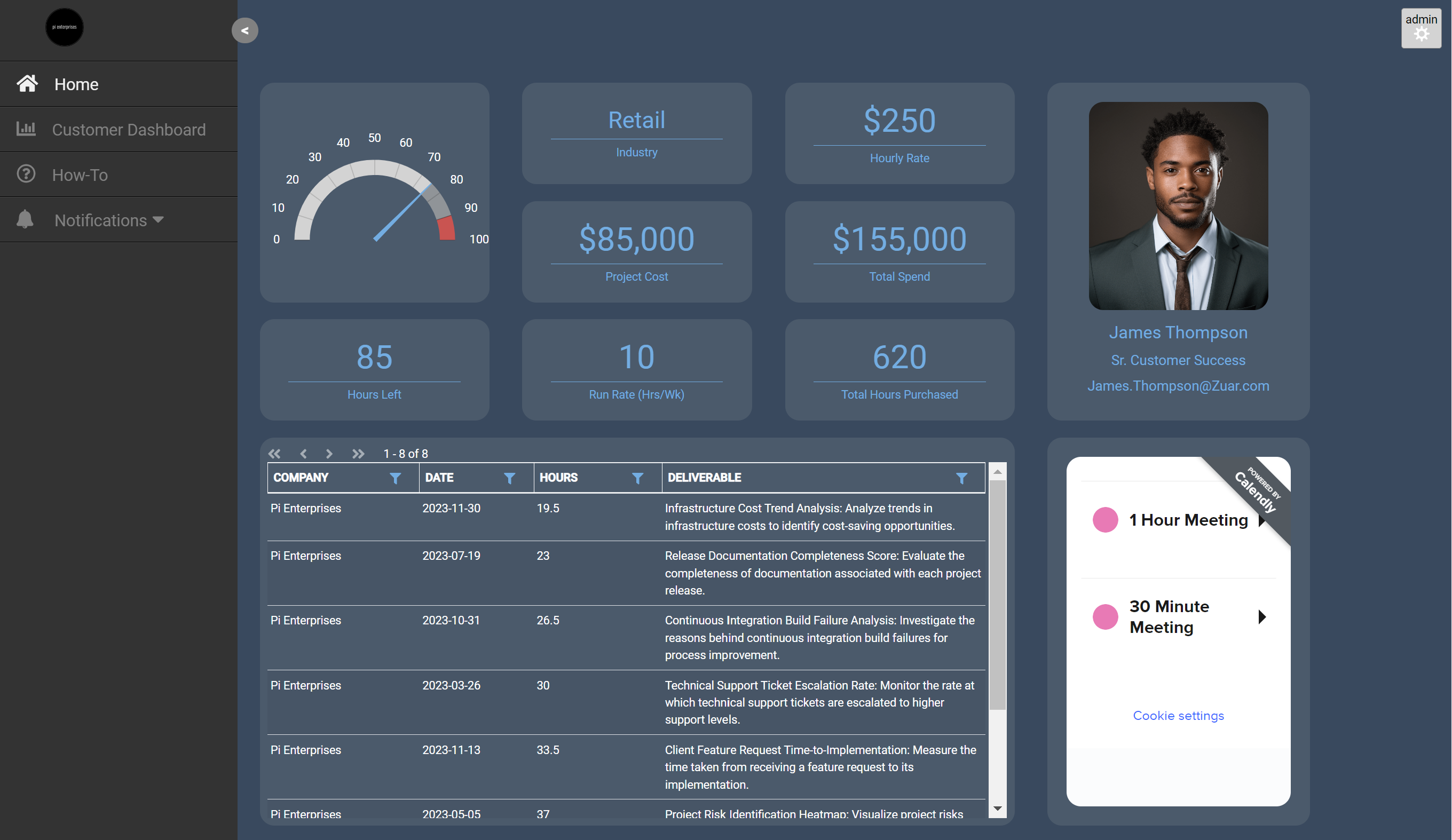The Ultimate Guide to Data Sharing: Comparing 3 Methods
In this article, we compare and contrast three data sharing methods: Excel spreadsheets, BI platforms, and data portals.

Introduction to Data Sharing
In an era where more data is being generated than ever before, businesses of all sizes rely on it to make informed decisions, track performance, and identify opportunities.
Data sharing plays a crucial role in ensuring that stakeholders, whether internal or external, have access to the data insights they need. However, not all data sharing methods are created equal.
Depending on the complexity of your organization, the volume of data, and the level of accessibility required, you may be using anything from distributing Excel spreadsheets to leveraging a fully-fledged data portal.
This article explores the evolution of data sharing, starting with the most basic form—Excel spreadsheets—and moving through to more advanced solutions like Business Intelligence (BI) platforms and data portals that enable self-service analytics.

The Basic Approach: Sharing Excel Spreadsheets
Excel is often the first tool organizations turn to for managing and sharing data. It's intuitive, widely used, and flexible enough to handle a variety of tasks, from basic calculations to some complex data models.
While that is all true, it has significant limitations when it comes to modern business data analytics. Relying solely on Excel for analytics can hinder decision-making processes, scalability, and data governance.

Pros of Excel Spreadsheets
- Simplicity and Familiarity: One of the primary reasons Excel remains popular for data sharing is its simplicity and familiarity. Most employees across various industries have used Excel at some point, which reduces the need for extensive training.
- Accessibility: Excel is widely accessible and available as part of Microsoft Office, a software suite used by a majority of businesses globally. This makes sharing files with internal teams, external partners, or clients convenient since almost everyone has access to the software.
- Low Cost: For many organizations, Excel is already part of their existing software package, meaning there’s no additional investment required to use it for data sharing.
Cons of Excel Spreadsheets
- Limited Scalability: Excel is not designed for handling large datasets. As the volume and complexity of data increase, Excel files can become slow, unresponsive, or even crash. Sharing large files also becomes cumbersome, leading to performance issues and making Excel a poor choice for businesses with large-scale data needs.
- Data Sharing Inefficiency: As Excel files are passed around through email or file-sharing platforms, there’s an increase in data silos and inefficiency. Without a centralized data source, team members may end up with multiple copies of the same file, resulting in disjointed data insights and collaboration difficulties.
- Version Control Issues: When sharing Excel spreadsheets across multiple users, version control can become a nightmare. Often, multiple versions of the same file are passed around, leading to confusion about which version contains the most accurate or up-to-date data.
- Manual Updates: Excel does not connect directly to real-time data sources. As a result, any updates to the data must be made manually. This means users need to continuously refresh and redistribute the file every time new information is added, which increases the risk of sharing outdated data.
- Data Integrity and Security Concerns: Sharing Excel spreadsheets via email or file-sharing services exposes data to potential security risks. Excel files are easy to copy, modify, or share without permission, creating concerns around data integrity and security. Sensitive data can be unintentionally exposed, especially if appropriate encryption or password protection is not used.
Excel can be an effective and affordable tool for basic data sharing within small teams or businesses with limited needs. However, as organizations grow and their data-sharing requirements become more complex, Excel’s limitations make it unsuitable for modern data environments.
For businesses that require real-time collaboration, secure data sharing, and automated insights, moving beyond Excel to more advanced tools is essential.

The Middle Ground: Sharing Dashboards via Business Intelligence Platforms
As businesses grow and data becomes more complex, many turn to Business Intelligence (BI) platforms to solve some of the challenges associated with Excel spreadsheets.
BI tools like Power BI, Tableau, ThoughtSpot, etc. enable organizations to visualize data, automate reporting, and make data more accessible through interactive dashboards.
However, due to their advanced features and complex data integration processes, BI platforms often have a steep learning curve, requiring users to undergo training or rely on technical expertise for setup and effective use.
Pros of BI Platforms
- Real-Time Data: BI platforms allow users to connect directly to live data sources, ensuring that data is always current. This eliminates the need for manual updates and provides real-time or near-real-time insights for decision-making, making it especially valuable for businesses that need up-to-date information to stay competitive.
- Interactive Dashboards: BI tools provide highly interactive dashboards that enable users to explore data dynamically. Features like drill-downs, filters, and customizable visualizations allow users to gain deeper insights without needing advanced technical skills, making it easier to share and interpret data across teams.
- Automated Reporting: One of the major benefits of BI platforms is the ability to automate reports. Users can schedule reports to be generated and shared automatically at set intervals, ensuring that all stakeholders have timely access to the latest data without manual intervention.
- Enhanced Data Governance and Security: BI platforms come with robust data governance and security features, such as role-based access controls. This ensures that sensitive data is only accessible by authorized users, improving security and compliance with regulations like GDPR. The ability to track and audit data access also ensures transparency in data sharing.
Cons of BI Platforms
- Cost: BI platforms can be expensive, especially for small organizations. Licensing fees, training, and implementation costs can add up.
- Complexity and Learning Curve: BI platforms, while powerful, often come with a steep learning curve. They require setup, data integration, and ongoing management, which may need technical expertise. Non-technical users might struggle to create and manage dashboards, requiring additional training or reliance on IT teams.
- Data Silos: Without proper management, BI platforms can contribute to the creation of new data silos within an organization. Different departments may build separate dashboards or reports that do not align with company-wide data strategies, leading to inconsistent insights across the organization.
- Ongoing Maintenance: BI platforms require regular maintenance to ensure that data connections are active, dashboards are up-to-date, and security settings are appropriately configured. This can be resource-intensive, requiring dedicated IT support or data professionals to manage the platform effectively.
BI platforms provide a significant step up from Excel by offering automation, real-time insights, and better governance, but they still often require specialized skills to manage and can come with high costs.

The Ultimate Solution: Implementing a Data Portal for Self-Service Analytics
As organizations continue to grow and data becomes an even more critical asset, the need for an enterprise-wide, scalable, and accessible data-sharing solution becomes paramount.
This is where self-service analytics portals, also known as data portals, come into play. These platforms not only centralize data but also empower non-technical users to access, analyze, and share insights on their own.
These platforms can often be connected directly to an organization's BI platform, enabling seamless integration with existing data sources and tools.
Zuar Portal is an example of a data portal that provides these capabilities and more. With Zuar Portal, organizations can streamline data access across departments, eliminating bottlenecks and reducing the dependency on IT teams.
Its intuitive interface enables users of all skill levels to interact with data effortlessly, while advanced security features ensure that sensitive information is protected.
With its customization capabilities, portals can be easily tailored to match company branding, offering a seamless user experience.

Pros of Data Portals
- Centralized Data Access: The primary benefit of data portals is that they integrate various applications, providing users with a single platform to access all of the organization’s data, documents, training, and more. This eliminates silos and ensures that everyone is working from the same source of truth.
- Self-Service Capabilities: Another benefit of data portals is that they enable users to access and explore data without needing to rely on a data analyst or IT team. Intuitive interfaces and inline training fosters a culture of data-driven decision-making throughout the organization.
- Enhanced Brand Experience: A well-designed data portal can provide a branded, seamless experience for both internal users and external stakeholders, such as clients or partners. By customizing the interface with company branding, logos, and consistent visuals, businesses can create a professional and cohesive environment that reinforces their brand identity.
- Scalability: Data portals are designed to scale with organizational growth. Whether handling large volumes of data, incorporating new data sources, or expanding access to more users, data portals can grow alongside the business without compromising performance.
- Real-Time Insights and Advanced Analytics: Like BI platforms, data portals connect to live data sources, ensuring that users always have access to the most up-to-date information. Additionally, many data portals offer advanced analytics features, such as predictive analytics, that go beyond what BI platforms typically provide.
Cons of Data Portals
- Initial Investment: Implementing a data portal requires an upfront investment in terms of both money and time. The cost of the software, along with the resources needed for implementation and training, can be a barrier for smaller organizations.
- Complex Implementation: Building an in-house data portal can be a challenging task that requires skilled personnel. However, opting for a no-code solution (like Zuar Portal) can simplify the process, making implementation easier and reducing the need for extensive technical expertise.
- Ongoing Maintenance: Data portals require ongoing integration management and content governance to keep data clean, secure, and accessible. However, when working with a data portal vendor like Zuar, maintenance becomes much easier, as the vendor often handles key updates and support, reducing the need for a dedicated in-house team while still ensuring that regular oversight is in place for optimal performance.
Despite these challenges, data portals represent the pinnacle of data sharing in organizations. They offer the most scalable, secure, and user-friendly way to democratize data, allowing non-technical users to gain insights without the need for heavy IT involvement.

Comparing the Three Methods
To summarize, here’s a quick comparison of Excel spreadsheets, BI platforms, and data portals:
| Feature | Excel Spreadsheets | BI Platforms | Data Portals |
| Scalability | Limited | Moderate | High |
| Data Freshness | Static | Real-time (connected to live data sources) | Real-time |
| Ease of Use | High (but manual) | Moderate | High (self-service) |
| Automation | None (manual updates required) | Automated dashboards | Automated insights and analytics |
| Cost | Low | Moderate to high | High (initial investment, scalable ROI) |
| Collaboration | Low (multiple versions, difficult to track) | Moderate (interactive dashboards) | High (centralized data, self-service) |
| Security and Governance | Low (manual controls, prone to errors) | High (role-based access) | High (granular control, compliance ready) |

Choosing the Right Data Sharing Solution
The choice between Excel spreadsheets, BI platforms, and data portals depends on the specific needs and maturity of your organization.
If you're a small business or team that only requires basic data management, Excel may serve your needs, but we would still recommend relying on it only in a supplementary capacity.
For organizations seeking more interactive and automated solutions, BI platforms offer a significant upgrade with real-time data and better governance.
However, for businesses looking to scale, centralize content, and empower a broader range of employees, clients, partners, and more to access and analyze data, a self-service analytics portal is the best long-term solution.
Data Sharing With Zuar Portal
While we are obviously biased, we recommend Zuar Portal as your data sharing solution. With it's simple drag-and-drop tools, you can build beautiful custom portals for your internal users, clients, partners, and more.
As a white-label platform, you can set up portals in a matter of minutes. Contrast that to building a data portal from scratch which can take months or years and requires deep expertise.
Additionally, by implementing Zuar Portal, you eliminate the need to retain dedicated personnel for ongoing maintenance and updates—we handle that for you.
Click here to learn more about Zuar Portal or start a free two-week trial:



